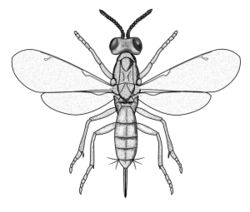Biology:Eupelmidae
| Eupelmidae | |
|---|---|

| |
| Eupelmus urozonus | |
| Scientific classification | |
| Domain: | Eukaryota |
| Kingdom: | Animalia |
| Phylum: | Arthropoda |
| Class: | Insecta |
| Order: | Hymenoptera |
| Superfamily: | Chalcidoidea |
| Family: | Eupelmidae Walker, 1833 |
| Subfamilies | |
| |
Eupelmidae is a family of parasitic wasps in the superfamily Chalcidoidea. The larvae of the majority are primary parasitoids, commonly on beetle larvae, though many other hosts are attacked, including spiders. Details of the life history varies considerably (e.g., some attack eggs and others are hyperparasites).[1] They are found throughout the world in virtually all habitats.
Description
They are somewhat variable in appearance, though a fair number of species are relatively easy to separate from other Chalcidoidea by the possession of a medially concave mesonotum. They also have the unusual tendency to arch the body strongly upwards when dead, with the head and metasoma often nearly touching above the thorax.[1]
Taxonomy
In 2022, genera previously placed in this family were moved to the families Metapelmatidae and Neanastatidae. As presently defined, there are 39 genera in Eupelmidae.[2]
Subfamily Calosotinae
Genera remaining after the loss of five genera to Eusandalinae:[3][2]
- Balcha
- Calosota
- Tanythorax
Subfamily Eusandalinae
Genera:[2]
- Archaeopelma
- Eusandalum
- Licrooides
- Paraeusandalum
- Pentacladia
Subfamily Eupelminae
Genera:[3]
- Anastatus
- Arachnophaga
- Australoodera
- Brasema
- Calymmochilus
- Cervicosus
- Coryptilus
- Ecnomocephala
- Enigmapelma
- Eueupelmus
- Eupelmus
- Eutreptopelma
- Lecaniobius
- Lutnes
- Macreupelmus
- Merostenus
- Mesocomys
- Omeganastatus
- Ooderella
- Oozetetes
- Paranastatus
- Phenaceupelmus
- Phlebopenes
- Psomizopelma
- Rhinoeupelmus
- Taphronotus
- Tineobiopsis
- Tineobius
- Uropelma
- Xenanastatus
- Zaischnopsis
References
- ↑ 1.0 1.1 Pitkin, B.R. (2004). "Notes on families: Eupelmidae". https://www.nhm.ac.uk/our-science/data/chalcidoids/eupelmidae.html.
- ↑ 2.0 2.1 2.2 , Wikidata Q115923766
- ↑ 3.0 3.1 Noyes, J.S. (March 2019). "Universal Chalcidoidea Database". The Natural History Museum. http://www.nhm.ac.uk/chalcidoids.
External links
Wikidata ☰ Q1938355 entry
 |


